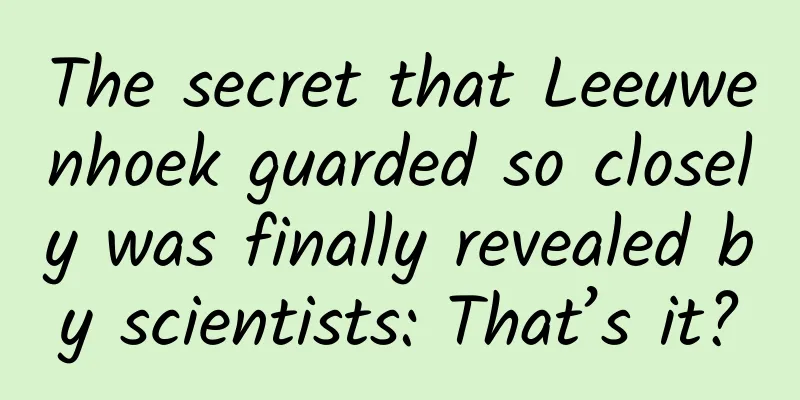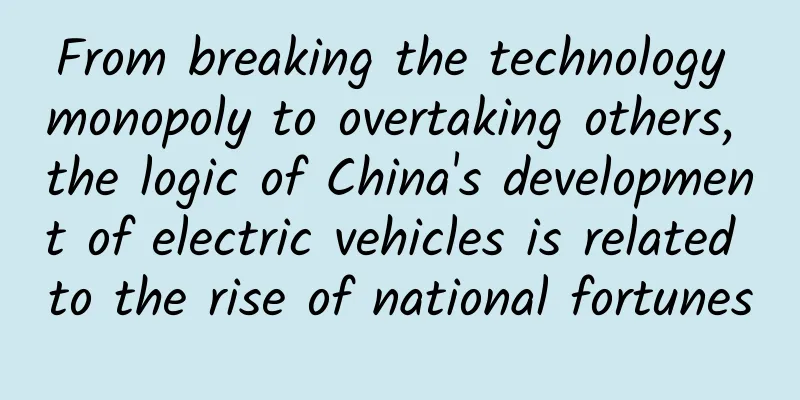The secret that Leeuwenhoek guarded so closely was finally revealed by scientists: That’s it?

|
In the 17th century, Dutch businessman Antonie van Leeuwenhoek used a homemade microscope to observe single-celled organisms for the first time, thus opening the door to microbiology for mankind. Leeuwenhoek was able to discover a world that no one had ever seen before because his microscope had a magnification that was an order of magnitude higher than that of his contemporary rivals. For example, the largest Leeuwenhoek microscope currently in existence can magnify objects 266 times. This man told the world the secrets of the microscopic world, but when asked what kind of lenses were hidden in his microscopes and what kind of process was used to make them, Leeuwenhoek kept his mouth shut. The outside world has always been very curious about this, even Robert Hooke, the predecessor who first discovered cells with a microscope, was no exception. Now, more than 300 years later, scientists from Delft University of Technology in the Netherlands finally saw what the lens looked like from the "266x scope", and at the same time they also felt a hint of subtlety for Robert Hooke. Why is it different from what we agreed? In the past, people mostly used X-rays to observe the inside of a Leeuwenhoek microscope, just like taking an X-ray in a hospital. Leeuwenhoek microscope, which can magnify objects 266 times, is housed in the Utrecht University Museum | Reference 1 However, the aperture of the Leeuwenhoek microscope is too small, less than 1 mm, and only a small part of the lens is exposed, while more than 90% is covered by the brass plate. X-rays cannot easily penetrate metal, so it is difficult to detect the shape of the lens inside. Therefore, instead of using X-rays, scientists at Delft University of Technology used neutron tomography. Compared with X-rays, neutron beams have a stronger ability to penetrate most metals. Neutrons are not severely attenuated by the influence of electrons outside the nucleus, while photons in X-rays are more easily absorbed or scattered by electrons. By emitting neutron beams, scientists can see what is inside the Leeuwenhoek microscope with the highest magnification without destroying the artifacts: Neutron tomography of a microscope (266x). The gray area is where the lens is. It is circular from all angles and has a diameter of about 1.3 mm. Reference 1 The left is the microscope (266x) and the right is after 3D reconstruction丨Reference 1 The brass plate that holds the lens is very thin, and the position where the lens is embedded is recessed. In this way, the front surface of the lens can protrude from the brass plate, and the lens can be closer and closer to the observed sample. Scientists believe that "close" is an important consideration in Leeuwenhoek's design. Of course, they are more concerned about the shape of the lens. The imaging shows that no matter from which direction the lens is viewed, the cross section is circular. In other words, it is a glass ball. And from the perspective of observing the object with a microscope (that is, the XZ direction in the figure), a glass line is found connecting the glass ball. A circle connected by a short line | Reference 1 But this result is very different from what the academic community previously believed. A major study in the past believed that the lens of this "266x telescope" was not spherical, but rather a slightly flattened sphere (see the picture below). Today's imaging results indicate that its lens is spherical, with a line added. A study in 1981 suggested that the lens of a microscope (266x) was made by blowing a glass tube into the shape of a light bulb and then breaking off the bulging part at the end. The resulting lens was relatively flat. When the scientists also took images using another medium-magnification Leeuwenhoek microscope, they found that the lens was much flatter, more like the shape of a lentil. Imaging results of a medium magnification (118x) microscope, with a flatter lens | Reference 1 The research team's results were published in the May issue of the journal Science Advances. The new imaging broke the old cognition, but it did not completely exceed the scientists' imagination, because they had an impression of the shape of a ball connected by a line. Why is it so similar to Hook's plan? In the 1670s, Leeuwenhoek placed a drop of pond water under a microscope and found that there were many "tiny animals" swimming around in it. From then on, he began to write letters to the Royal Academy of England describing the "tiny animals" he saw in various samples. Today we know that he saw microorganisms. But in the eyes of people at that time, the scene described in the letter was unbelievable, and Leeuwenhoek refused to disclose what equipment he used, which led to doubts and ridicule. In 1676, the Royal Society questioned the authenticity of those "microscopic animals". At Leeuwenhoek's insistence, the Royal Society arranged for several high-ranking religious figures to verify his observations. In 1677, Leeuwenhoek's discovery was recognized. But the secrets of the microscope were not revealed. Robert Hooke, then secretary of the Royal Society and the first person to see cells with a microscope, complained about Leeuwenhoek's secrecy. Regardless of politics, the transparency and reproducibility of a scientific discovery are also factors that the Royal Society values. In 1678, Hooke published a "super simple" solution himself: Place a thin glass rod over a flame and as it slowly melts, the end will curl into a small ball. Break off the ball, leaving a small handle for easy assembly. Scientists reconstruct the shape of the lens | Rijksmuseum Boerhaave A small ball connected to a string. More than three centuries later, scientists have finally discovered that the lens of Leeuwenhoek's microscope, which can magnify objects 266 times, is very consistent with Hooke's "super simple" solution. This scheme is actually a variation of a method introduced in Hooke's Micrographia in 1665. The only difference is the small handle, which the book once thought needed to be ground off. The era when Micrographia was popular was earlier than Leeuwenhoek's entire career of making microscopes. Therefore, the manufacturing of the "266x scope" is likely to have borrowed from Hooke's method rather than using any secret process. This discovery made the research team believe that Leeuwenhoek's secrecy was intentional against his competitors. In 1685, the persistent Hooke sent a member of the Royal Society to Delft, the Netherlands, to try to obtain some details of the microscope from Leeuwenhoek, but still to no avail. Today, scientists also feel a little ironic for Hooke, because the answer he had been looking for may have been in his own heart. Even so, it was Leeuwenhoek's own skills that made Hooke's method the most effective at the time. The magnification of Leeuwenhoek's microscope was not surpassed until more than 100 years later. I can't finish the research. Originally, Leeuwenhoek was a cloth merchant who wanted a tool that would allow him to see each silk thread more clearly in order to judge its quality. After traveling to Britain and being inspired by Hooke's "Microscopic Atlas", Leeuwenhoek became obsessed with studying microscopic technology. He observed various cells and drew them, such as 1-4 for rabbit sperm and 5-8 for dog sperm. Anthony van Leeuwenhoek He built more than 400 microscopes in his lifetime, and was skilled in grinding lenses, firework and blowing. In addition to those routine operations, Leeuwenhoek may have explored some tools that seem incredible to the outside world: historical documents show that he once used a cod egg as a lens to observe the inverted image of the surrounding objects. However, only 11 of the more than 400 microscopes are still in existence, and Leeuwenhoek's own description of the process is very limited, so the outside world knows very little about his microscope manufacturing methods, and most of the information remains to be discovered. The scientists also wrote in the paper that the process used by Leeuwenhoek to make microscope lenses will never be exhausted no matter how much research is done, because no process can be completely eliminated. References [1] Cocquyt, T., Zhou, Z., Plomp, J., & Van Eijck, L. (2021). Neutron tomography of Van Leeuwenhoek's microscopes. Science Advances, 7(20), eabf2402. [2] van Zuylen, J. (1981). The microscopes of Antoni van Leeuwenhoek. Journal of microscopy, 121(3), 309-328. [3] Dobell, C. (1932). Antony van Leeuwenhoek and his "Little Animals." Being Some Account of the Father of Protozoology and Bacteriology and his Multifarious Discoveries in these Disciplines. [4] Schierbeek, A., & Rooseboom, M. (1959). Measuring the invisible world: the life and works of Antoni van Leeuwenhoek (No. 37). Abelard-Schuman. Author: Li Zi Editor: Odette |
<<: 【Smart Farmers】Food Talk: A Picture to Understand Misunderstood Food Additives
Recommend
Case analysis: Ele.me’s 10 billion bean event on Double 11
The annual Double 11 carnival is approaching. In ...
React chapter of the front-end interview handbook, dismantling the real interview questions of large companies and conquering the core test points of React
React chapter of the front-end interview handbook...
IBM versus Amazon Cloud Computing: Can Big Blue disrupt itself?
After ten consecutive quarters of shrinking perfo...
Analysis of short video platforms such as Kuaishou and Douyin!
In recent years, the short video track has been q...
The document save button actually has a physical version?
On August 12, 1981, International Business Machin...
Will carrier subsidy cuts really affect Apple?
With the substantial reduction in terminal subsid...
From PPT-onlyism to self-licking philosophy, how did Hisense crush Samsung?
Spring has arrived again. At the beginning of Mar...
Using Tik Tok recommendation algorithm for brand promotion
Speaking of the sudden emergence of Toutiao, a ve...
50 million alliance: 0 fans bring over 10,000 GMV to the community
Community introduction: How to quickly get more t...
iOS 15.5 serious bug has been fixed, iOS 16 will be released the day after tomorrow
It is June, and the Apple WWDC2022 conference is ...
Enjoy music anytime, anywhere with Dianmang 2 face personalized experience
With the acceleration of the pace of life and the...
How to use the 4 key points of the addiction model to design a community with high conversion rates?
Recently, I read a book called "Addiction&qu...
Is human the most dangerous animal in the world? Check out the correct answer
Figure 1: The deadliest animals. Ranked by estima...
What should I do if I have no experience and no one to guide me?
Some classmates left me a message asking, "I...









